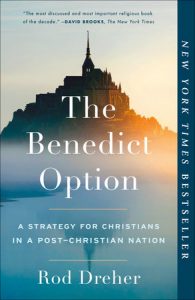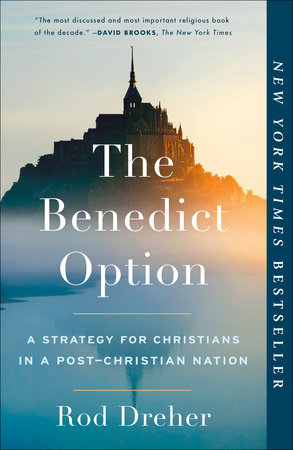Dreher, Rod. The Benedict Option: A Strategy for Christians in a Post-Christian Nation. New York, NY: Sentinel, 2017, pp. 304, $17, paperback.
Rod Dreher is a popular Christian author and blogger and is senior editor at The American Conservative. He has written several books: Cruchy Cons (2006), The Little Way of Ruthie Leming (2013), and How Dante Can Save Your Life (2015). His most recent book, The Benedict Option, is a bestseller and has prompted discussions in churches and small groups around the world.
In The Benedict Option, Dreher announces that conservative Christians have lost the culture war and that a new dark age is approaching. According to Dreher, the Waterloo of Christian conservatism was the legalization of same-sex marriage in the U.S. Supreme Court case, Obergefell v. Hodges (p. 9), and the enemies are several: secularism (9), moral therapeutic deism (the belief that God just wants us to be happy, pp. 10-11), and consumerism (p. 11). In response, Dreher calls Christians to withdraw strategically and form communities modeled after the sixth-century monastic, Saint Benedict, who, in order to preserve Christian culture and values safe from the cultural demise following the fall of Rome, started a monastic community at Monte Cassino in Italy. Dreher is not calling Christians to become Benedictine monks—although it is easy to be confused about this, given the title of his book. Dreher’s principled application of Benedict for contemporary believers is “[working] on building communities, institutions, and networks of resistance that can outwit, outlast, and eventually overcome the occupation” (p. 12). This involves applying selected features of Benedict’s handbook, the Rule of Saint Benedict, which are the following: living a life of order, prayer, stability, asceticism, stability, community, hospitality, and balance.
It also means applying “Benedictine spirituality” to every area of social life, including politics and education. In politics, for example, Dreher claims that Christians are “politically homeless” (p. 80). Democrats have not supported Christian values, and Republicans have been more interested in power and the economy. It is a mistake, he says, to think that the church is “the Republican Party at prayer” (p. 78) or that someone as “morally compromised as Trump” will save us (p. 79). Moreover, Christians must not think fighting the culture war was ever as easy as simply voting since laws do not change the heart. A Benedictine withdrawal from politics does not mean complete capitulation; it just means being more prudent and focusing on the political issues that matter most, such as religious liberty and local problems. Dreher also says Christians should still look for ways to cross the aisle and work with liberals to “combat sex trafficking, poverty, AIDS, and the like” (p. 83).
Dreher calls Christian parents to pull their kids out of public schools (p. 155), and he wants them to pull their children out of regular Christian schools, too (pp. 158-159). Public schools teach liberal sexual values and only prepare children for the workforce. Private Christian schools may not teach the same sexual values, but they use the same workforce development model of education and, as an afterthought, require a few Bible classes. Dreher says, “The trite theological education many received at Christian school will serve more as a vaccination against taking the faith seriously than as an incentive for it” (p. 159). Instead, Christian families should pursue a classical Christian education, which takes an integrated approach to its curriculum, ordering all learning in accordance with the Christian worldview. If classical education is not an option, he says, then Christians should homeschool their children instead.
Dreher is correct in identifying deep flaws in both public and private schools and in criticizing those who think that the best hope for cultural change lies in politics. He is also correct in his description of the corrupting effects of technology and the pernicious nature of pornography. Hopefully, Dreher’s message will awaken the slumbering church to the dangers of moral therapeutic deism and cause parents to rethink their parenting and educational strategies in order to provide their children the best chance of catching the Christian vision of the good life.
However, I have a few points of criticism. Dreher’s prophetic description of our cultural demise may be correct, but it also may be too soon. Certainly, it is difficult to be a conservative Christian in the United States these days, but political correctness and rampant consumerism is not the same as religious persecution. Christians are not yet suffering in our country in ways they have in other times and places.
Moreover, Dreher’s Benedictine prescription raises a couple of concerns. First, the fundamentalist movement of the early twentieth century similarly called for strategic withdrawal from the public square, but many Christians think it was a mistake and did more harm than good. How is the Benedict Option different from the fundamentalist movement? I put this question to Mr. Dreher at a recent talk he gave, and his answer was that the fundamentalists understood something important, but the early twentieth century was too early for such a strategy. Also, fundamentalism is often accompanied with anger and “siege mentality,” but Christians should be characterized by joy and hope in spite of adversity. He may be right about fundamentalism, but many readers will not be convinced that now is the right time for a Benedictine withdrawal. Many Christians still take seriously Jesus’ call in Matthew 5:13-16 to be salt and light in the world and are intentionally active in the world for this reason. Such Christians have not yet given up hope that the fields are still ripe for the harvest.
Second, Dreher does not give adequate attention to one particularly important opportunity and responsibility that the church has at the present time. Our society has seen racism and hate arise in ways not many could have predicted just a decade ago. This is an excellent opportunity for the church to be a light, demonstrating Christ’s love for people of all races and showing the country what true Christian love looks like in a diverse society like ours. Unfortunately, when the church reflects on its own (lack of) accomplishments in this area, Christians should consider the great responsibility and unfinished work we still have. For example, Sunday mornings continue to be the most segregated mornings of the week, and the price of Christian private schooling has created access problems for people of color. The “strategic withdrawal” Dreher proposes would likely increase the segregation in our communities unless the church addresses this. To his credit, Dreher sees the problem. He acknowledges that in the past many private schools in the South have been known as “segregation academies.” He says, “Benedict Option schools would be wise to make special efforts toward racial reconciliation by recruiting black families, especially given that public schools are effectively resegregating. Additionally, the future of Christianity in America, both Catholic and Evangelical, is going to be a lot more Hispanic. So should the future of Christian schooling” (p. 159). However, Dreher says nothing more about this and gives no practical advice for addressing it. Our society needs racial reconciliation, and this is an opportunity for the church to shine. We need to make sure that any withdrawal does not lead to increased segregation. I hope Dreher can offer some practical advice for making racial reconciliation and desegregation a reality in Benedictine communities.
Gregory L. Bock
The University of Texas at Tyler





